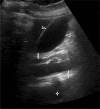Diagnostic accuracy of ultrasonography in adults with obstructive jaundice
- PMID: 32609962
- PMCID: PMC7409548
- DOI: 10.15557/JoU.2020.0016
Diagnostic accuracy of ultrasonography in adults with obstructive jaundice
Abstract
Aim of the study: To determine the sensitivity and specificity of ultrasound for detecting the causes of obstructive jaundice. Materials and methods: Eighty adult patients with clinical and biochemical features of obstructive jaundice were enrolled in this study. The causes, degrees and levels of ductal obstruction were evaluated sonographically via the transabdominal route. The ultrasonographic diagnoses were correlated with surgical findings and histopathological diagnoses. Results: The age range was 16 to 82 years, with a mean of 51.06 ± 14.95 years. The peak age group was the sixth decade with 23 (28.8%) patients. There were nearly twice as many females as males, with 28 (35%) males and 52 (65%) females, giving a male to female ratio of 1:1.9. On ultrasound, pancreatic carcinoma (28.0%) and choledocholithiasis (21.3%) were the most common malignant and benign causes of obstructive jaundice, respectively. Hepatocellular carcinoma (1.3%) was the least common etiology. There was a strong correlation between the definitive diagnosis and the sonographic level of obstruction. The overall sensitivity of ultrasound for detecting the cause of obstruction was 76.6%, while the specificity was 98%. Conclusion: Ultrasonography is a reliable imaging modality for diagnosing the cause and level of obstruction in surgical jaundice. The sensitivity is adequate to aid the early institution of surgical intervention, thereby preventing morbidity and mortality that may accompany late interventions in our setting.
Aim of the study: To determine the sensitivity and specificity of ultrasound for detecting the causes of obstructive jaundice. Materials and methods: Eighty adult patients with clinical and biochemical features of obstructive jaundice were enrolled in this study. The causes, degrees and levels of ductal obstruction were evaluated sonographically via the transabdominal route. The ultrasonographic diagnoses were correlated with surgical findings and histopathological diagnoses. Results: The age range was 16 to 82 years, with a mean of 51.06 ± 14.95 years. The peak age group was the sixth decade with 23 (28.8%) patients. There were nearly twice as many females as males, with 28 (35%) males and 52 (65%) females, giving a male to female ratio of 1:1.9. On ultrasound, pancreatic carcinoma (28.0%) and choledocholithiasis (21.3%) were the most common malignant and benign causes of obstructive jaundice, respectively. Hepatocellular carcinoma (1.3%) was the least common etiology. There was a strong correlation between the definitive diagnosis and the sonographic level of obstruction. The overall sensitivity of ultrasound for detecting the cause of obstruction was 76.6%, while the specificity was 98%. Conclusion: Ultrasonography is a reliable imaging modality for diagnosing the cause and level of obstruction in surgical jaundice. The sensitivity is adequate to aid the early institution of surgical intervention, thereby preventing morbidity and mortality that may accompany late interventions in our setting.
Conflict of interest statement
Figures



Similar articles
-
Aetiological spectrum of obstructive jaundice and diagnostic ability of ultrasonography: a clinician's perspective.Trop Gastroenterol. 1999 Oct-Dec;20(4):167-9. Trop Gastroenterol. 1999. PMID: 10769604
-
Validity of ultrasonography in diagnosing obstructive jaundice.East Afr Med J. 2005 Jul;82(7):379-81. East Afr Med J. 2005. PMID: 16167714 Clinical Trial.
-
Role of ultrasound as compared with ERCP in patient with obstructive jaundice.Kathmandu Univ Med J (KUMJ). 2013 Jul-Sep;11(43):237-40. doi: 10.3126/kumj.v11i3.12512. Kathmandu Univ Med J (KUMJ). 2013. PMID: 24442173
-
Hepatocellular carcinoma with obstructive jaundice: diagnosis, treatment and prognosis.World J Gastroenterol. 2003 Mar;9(3):385-91. doi: 10.3748/wjg.v9.i3.385. World J Gastroenterol. 2003. PMID: 12632482 Free PMC article. Review.
-
Pathophysiology and current concepts in the diagnosis of obstructive jaundice.Gastroenterologist. 1995 Jun;3(2):105-18. Gastroenterologist. 1995. PMID: 7640942 Review.
Cited by
-
Diagnostic accuracy of ultrasound and computed tomography in obstructive jaundice at emergency department: a retrospective study.BMC Emerg Med. 2025 Aug 26;25(1):169. doi: 10.1186/s12873-025-01328-3. BMC Emerg Med. 2025. PMID: 40859119 Free PMC article.
-
Ultrasonographic evaluation of patients with abnormal liver function tests in the emergency department.Ultrasonography. 2022 Apr;41(2):243-262. doi: 10.14366/usg.21152. Epub 2021 Nov 18. Ultrasonography. 2022. PMID: 35026887 Free PMC article.
-
A Rare Case of Metastasis to the Pancreas From a Primary Transitional-Cell Urinary Bladder Carcinoma.Cureus. 2022 Nov 16;14(11):e31580. doi: 10.7759/cureus.31580. eCollection 2022 Nov. Cureus. 2022. PMID: 36540441 Free PMC article.
-
Predictive Value of Transabdominal Ultrasonography in Detecting Extrahepatic Bile Duct Obstructive Lesions Compared with Endoscopic Retrograde Cholangiopancreatography.Pak J Med Sci. 2025 Feb;41(2):384-392. doi: 10.12669/pjms.41.2.9613. Pak J Med Sci. 2025. PMID: 39926694 Free PMC article.
-
Diagnosis of Cholangiocarcinoma.Diagnostics (Basel). 2023 Jan 8;13(2):233. doi: 10.3390/diagnostics13020233. Diagnostics (Basel). 2023. PMID: 36673043 Free PMC article. Review.
References
-
- Dodiyi-Manuel A, Jebbin N: Management of obstructive jaundice: experience in a tertiary centre in Nigeria. Asian J Med Clin Sci 2013; 2: 21–23.
-
- Gameraddin M, Omer S, Salih S, Elsayed SA, Alshaikh A: Sonographic evaluation of obstructive jaundice. Open J Med Imaging 2015; 5: 24–29.
-
- Bhargava S, Thingujam U, Bhatt S, Kumari R, Bhargava S: Imaging in obstructive jaundice: a review with our experience. JIMSA 2013; 26: 43–46.
LinkOut - more resources
Full Text Sources
